|
Peale's Parrot Finch
Erythrura pealii (PEALE, 1848)

Peale’s Parrot-finches are among the Estrildian finches that got to Europe quite early, already 1898 the first birds showed up in France. There were several attempts to establish the birds among the European aviculturists but with little success. Not until 1960 did the first bigger import arrive in 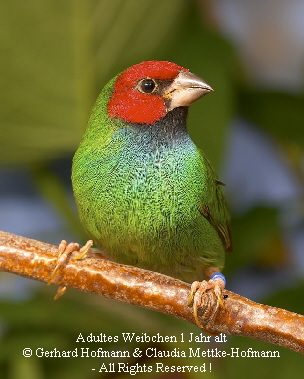 Europe. This was the start of a story of success and failure with this species. The not so overwhelming breeding results and the still relatively high price show that the species even nowadays is still not really easy to breed. Europe. This was the start of a story of success and failure with this species. The not so overwhelming breeding results and the still relatively high price show that the species even nowadays is still not really easy to breed.
Fiji and islands with names as melodies as Kandavu, Viti Levu, Vanua Levu or Taveuni are their places of origin. The birds inhabit the grassland, the rice-fields as well as forest-edges and clearings of the lowland rainforest. They avoid elevation above 1100m.
Peales feed on a large variety of grass-seeds, rice, herbaceous plant seeds, figs, nectar, pollen and insects as well as berries they truly belong to the generalists. They gather in large flocks on the rice fields when the rice just starts to get ripe and feed on their favorite food half-ripe rice.
At the beginning wild caught birds are usually extremely shy and need great care the first couple of days. They don’t adapt as well and as fast to their new environment in captivity as for instance Forbes Parrot-finches. Often it is necessary to cover at least part of the cage with a white sheet and wait to open this cover until the birds no longer panic in the presence of humans. I would not recommend keeping freshly wild caught birds in large aviaries due to their panic and fast flight there is always the danger that the birds injure themselves. The birds usually readily accept new food like spay millet, 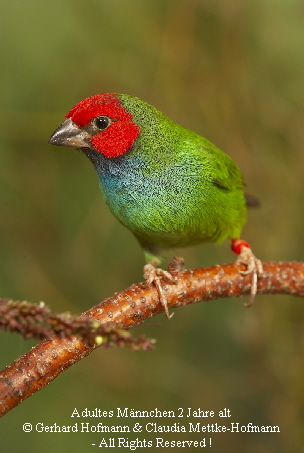 canary seeds, grass seeds, and a millet mixture. Like other birds feeding on insects Peales are often infected with tape-worms. Therefore it is a good idea to screen the feces for them and in case of an infection treating the birds before they get in contact with the own birds. canary seeds, grass seeds, and a millet mixture. Like other birds feeding on insects Peales are often infected with tape-worms. Therefore it is a good idea to screen the feces for them and in case of an infection treating the birds before they get in contact with the own birds.
Despite the fact that it seems to be no longer possible to get wild caught birds it is always good to be as careful with new purchased Peales as one would be with wild caught birds. Birds which are adapted to the way how they will be fed and housed the next couple of years are the fundament for successful breeding this species
One of the major problems with the species is to sex the birds. Usually it is not a big deal to sex birds origin from the own breeding stock but it is a whole different story to sex a single bird on a bird show which looks like the perfect match for the lonely male at home.
The black throat which is more grayish in females is the most reliable sign with our birds and if a bird with a grayish throat has less saturated blue on the chest as well as less saturated red on the head and even the green plumage on the belly is kind of yellowish we are nearly 99.9% sure to have a female. Sadly the red and green coloration vary and depend somehow on how the birds are housed and fed during moult...
Another reliable indicator is the song of the male. Normally Peales males start to sing their long trill song pretty soon after the feel comfortable in their new environment. If you still feel uncertain about the sex of the new bird I would go straight for a DNA- analysis using a feather sample of the bird. Nowadays there are plenty institutions offering an affordable and reliable way of sexing birds.
Peales are extremely active birds which seem not to be able to pause for even a single moment; hence they are not the birds for people who only can offer small breeding cages. At least after the breeding season they should be housed in a large well structured and if possible planted aviary.
Our smallest breeding cages are 1.2 x 0.5 x 0.5m and this as small as I would go definitely not smaller. During the non-breeding season we house males and females in separate aviaries. If both sexes are kept in the same aviary the males often start to chase the females which can be pretty stressful for them. Often they get plucked around the neck by the cocks and can never really recover from the breeding season. A large well planted aviary offers enough space for the birds and keeps them occupied exploring the environment. In planted aviaries Peales get tame much faster than in deprived aviaries. Sometimes they even take mealworms or millet-spray offered by hand. The best solution would certainly be an outdoor-aviary connected to a well heated indoor-aviary. The birds can spend the sunny times outside hunt for insects in the scrubs and can seek shelter inside in case of adverse weather conditions. Older Peales often get problems with ruffled feathers and get fat quite easily such problems are virtually unknown with birds kept in this combined indoor/outdoor- aviaries.
Nutrition: Like most Parrot finches Peales are not difficult to feed, but one has to take into account how the birds are housed. The nutrition should be according to the accommodation. For instance birds kept in large aviaries burn more calories then the ones kept in cages, the same is true for birds kept at lower temperatures or even just with lower temperatures during the night. If we don’t control the nutrition for these factors Peales may get fat and even infertile in just one season. The best way for beginners is probably to check the body condition and adjust the amount and the composition of the food of the birds until one is sure they don’t gain too much weight. As Peales are prone to obesity we keep our Peales on a strict seasonal diet with an austerity period during the non-breeding season. It not only helps to keep the birds in good shape but also helps synchronize the birds for the next breeding season and keeps down all the hormones that stimulate breeding and courtship.
As already mentioned Peales are generalists and feed on an impressive variety of seeds, fruits, berries and insects and even nectar and pollen.
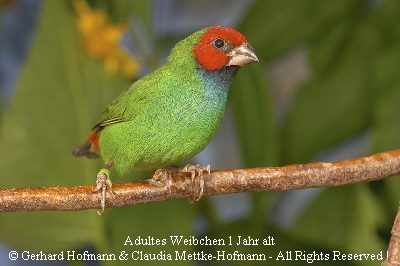
The diet of the Peales Parrot finch is similar to the diet of the more common Red-headed Parrot finch but should on average contain less nutritious seeds. We offer a special mixture for Parrot finches from Blattner as well as a grass seed mixture from the same company. Luckily the birds like these grass seeds particularly Orchard grass followed by annual ray grass and annual Meadow grass very much. The tiny seeds help to keep them busy and in a healthy body condition. We offer the larger sorts of seeds like white millet and canary seed only during the breeding period. Germinated and soaked seeds are also offered mainly during the breeding season. Half-ripe Millet spray and all kinds of seeding wild meadow grass and chickweed and cucumbers sliced in half are among the favorites with our Peales but one has to be careful not to offer to much of the millet as some birds will take only this and nothing else. Grass-seeds and green food can be offered in large quantities without problems.
Nearly all of our pairs are eager for living insects but will also accept frosted insects like Buffalo worms and Pinkies which we mix with a commercial dry eggfood. Most of our pairs certainly would raise their offspring without live food but as some pairs won’t hence we keep all on a standard diet with very little frozen insects mixed with soft food. Fruits like grapes, apples or berries like sea buckthorn and mountain ash are often accepted right on the spot and are a welcomed enrichment of the diet. Most birds like figs but as they are very nutritious we no longer offer them. Sand, cuttle bone, and crushed oyster shell and a mineral block should be av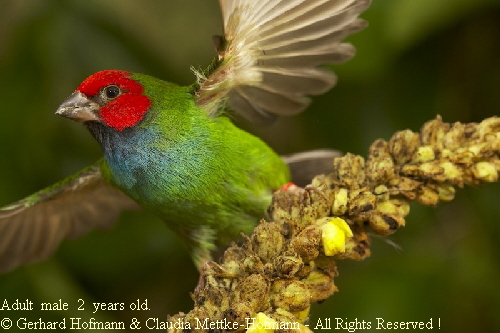 ailable daily, as should crushed baked poultry eggshells and mineralized grit. To prevent egg binding, we start to dust the offered seeds with Nekton MSA one to two months before the breeding season. ailable daily, as should crushed baked poultry eggshells and mineralized grit. To prevent egg binding, we start to dust the offered seeds with Nekton MSA one to two months before the breeding season.
We can’t emphasize enough how important it is to take into account how the birds are kept and adjust the food for it and also to keep the species on a strict seasonal diet with a lean period during the non-breeding season.
Nowadays Peales are among the species bred regularly but never in really large numbers like the Forbes-, Blue-faced-, or Red-headed Parrot finches. The reason is for sure not that they are less popular among aviculturists but that they are simply not that easy to breed. Often a pair is successful in one year but fails the next season, and there are still quite a few people who don’t select for good breeders but foster every clutch without need usually with the help of Bengalese. This habit doesn’t help to get a population of good breeders either.
Some of the common things which can go wrong are:
-not fertile (main reason: often the birds are too fat)
-deserted clutch or babies (possible reasons: Cage to small, wrong place where the nest box hangs, pair is not getting along)
- pair did raise their offspring last year but not this year (Possible reasons: Mates are not synchronized, birds didn’t have a real lean non-breeding season)
-male gets crazy and is chasing it’s mate or even attacking her (possible reasons: Cage too small, no cover (plants) means no place to hide for the female, offered food is not suitable often too much protein, geminated seeds or vitamin supplements)
But live isn’t that bad all the time and quite often one has diligent parents which raise brood after brood. Due to space constraints we keep most of our birds in large breeding cages but would prefer to keep them in aviaries as some birds tend to breed more reliable the more space they have. To keep more than one pair of breeding Peales is not a good idea. First of all, the males will fight with each other and second the hens will suffer hardly because of the attacking males. We also would not recommend keeping them together with other Parrot finches as in their free time Peales-males try to copulate with every parrot finch-hen available and they don’t even care if it is another species; hybrids are quite common in this case.
Courtship of the Peales male –as with most relatives of the Peales- is a rather rough chase of the female. Copula mostly takes place in the nest but some males are just too much on testosterone and will virtually rape their mate. Due to this it is not uncommon that females loose some feathers around the neck. One has to observe the pairs carefully as some males can injure their hens seriously. This is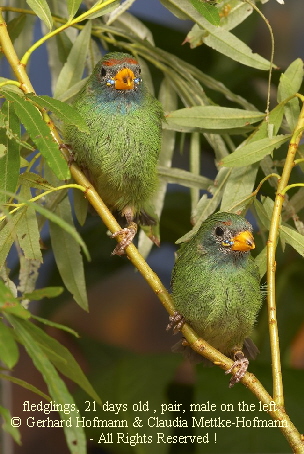 one of the reasons we prefer to pair experienced females with younger males and not the other way round. one of the reasons we prefer to pair experienced females with younger males and not the other way round.
Peales like to build their nests in standard wooden nest boxes which should not be too small, we use boxes with the size of at least 12 x 12 x 12cm half the front is open, some pairs prefer common nest-boxes used for budgerigar. As a kind of forest (edge) bird they most likely will choose a hidden shadowed area for their nest. They are happy with coconut fibres as nesting material but will take dry grass and leaves as well. They don’t use feathers or other soft material for lining the nest. Some pairs are really nervous and will leave the clutch with the slightest disturbance. In this case it is a good idea to give the nest some cover so that people cannot look directly into the nest entrance.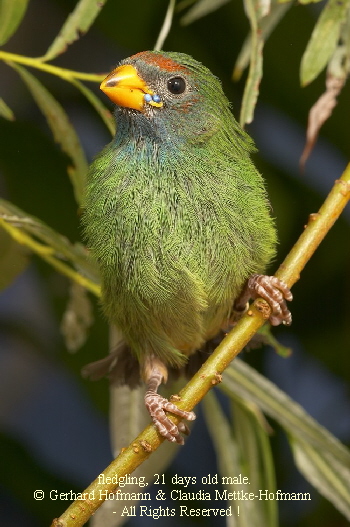
The clutch size is three to six eggs, after 13-15 days the babies hatch. Some pairs are brooding their nestlings rather long sometimes even until they fledge but the majority stops brooding around day seven to nine so it is good to have heated nest-boxes in case the birds breed in an outdoor-aviary and you hit a cold spell. The short brooding period was one of the main reasons for failure in the early days but as now more and more people keep their breeding stock indoors this no longer is the case.
The juveniles stay in the nest for approximately 21 days and can often be sexed already after fledging. The young males often are more colourful then their female siblings (see pictures). After fledging the young very rarely go back in the nest for the night. Usually they sit somewhere in the dense vegetation cuddling with their siblings - a behavior they don’t show as adults. The first one to two days they seem to be quite tame and don’t take off when approached, but it is probably simply the better strategy for them to trust the camouflage than to flee as they won’t anyway be fast and experienced enough at this age.
In outdoor aviaries, it is now the time to keep an eye on them - one cold night can be already fatal for them. One week after fledging they start to feed on their own but will be fed by their parents for another week. Because the mother may already incubate another clutch (Parrot finches are famous for this) mostly the father will do the job. Usually the birds build a new nest rather quickly of course there has to be a second nest-box available for them. For some pairs this fast follow up brood is no problem and quite often the male really needs this kind of workout to get “his hormones under control”, there may be some trouble if the fledglings are too curious and disturb the breeding mother. If the pair is kept in an aviary this is usually no problem and if it is even a planted one the fledglings will be occupied exploring their new and exiting world. In the case the fledglings have to be removed one has to wait until they are independent which is around 14 days after fledging Moult into adult plumage takes up to four months but is not a big deal for the birds. As with several species the colors gets more vibrant when the birds are two years old.
Good luck with this avian jewel from the Fiji.
All images and text and are Copyright © 2007 of Hofmann-photography and may not be used without the permission of the authors.
|